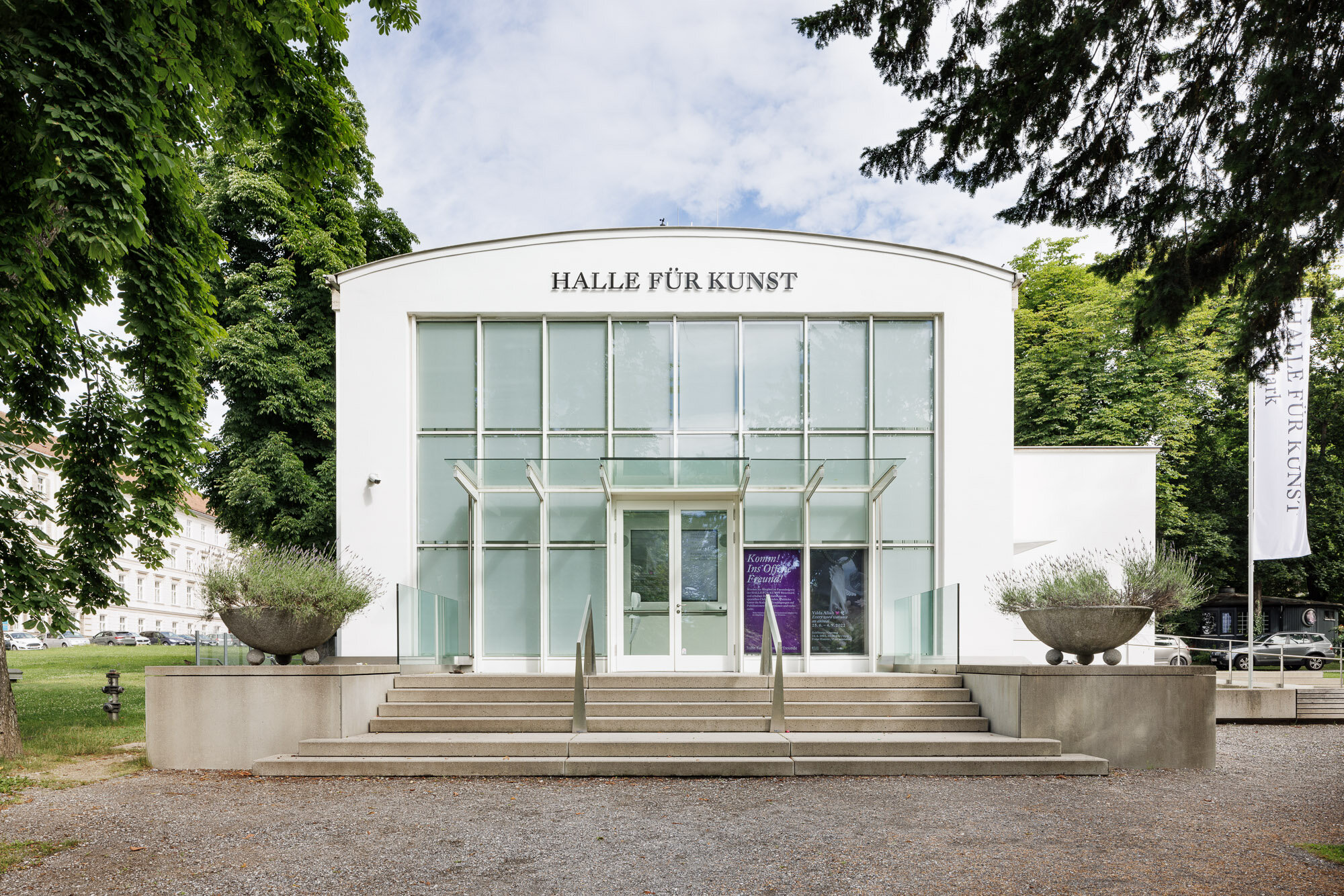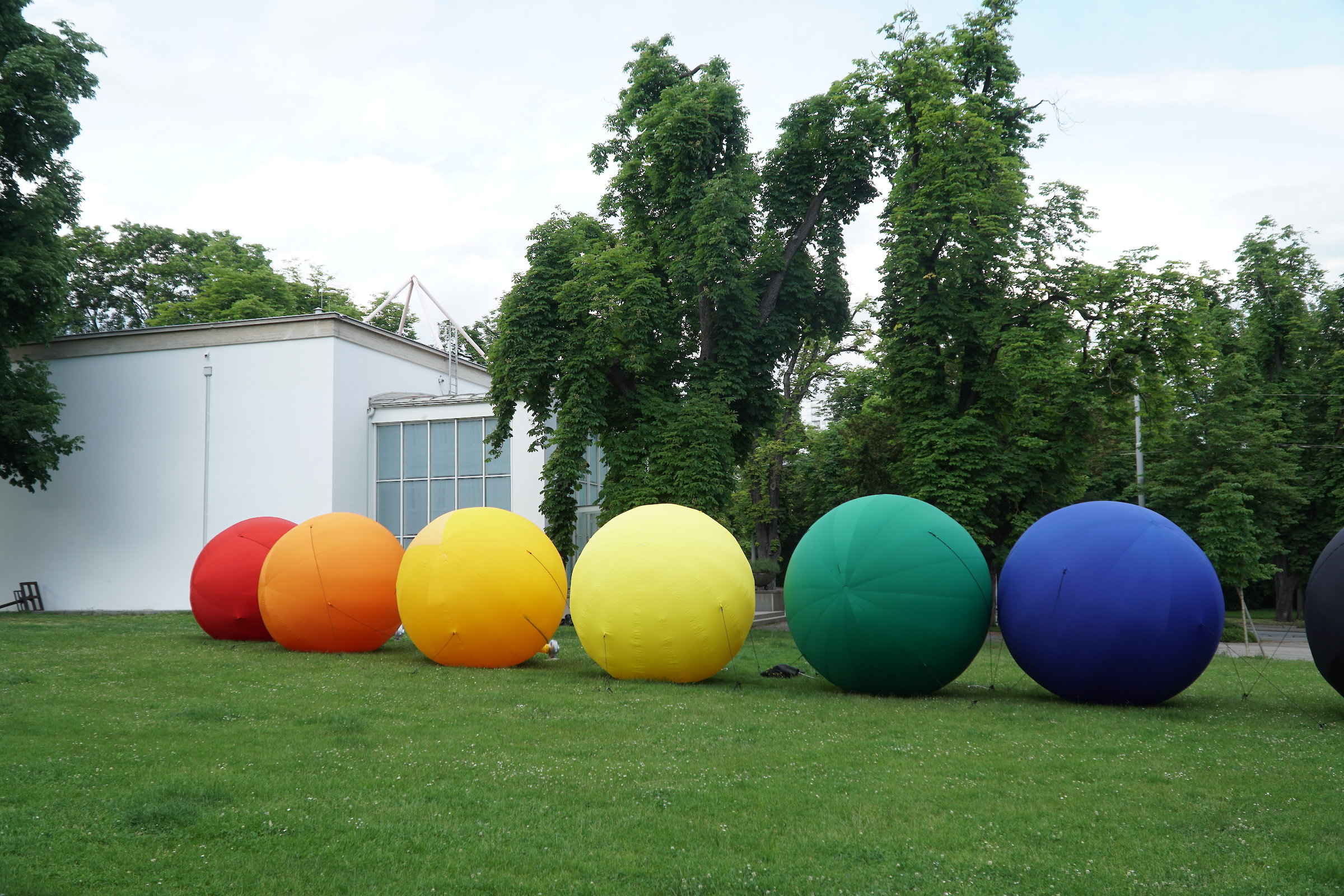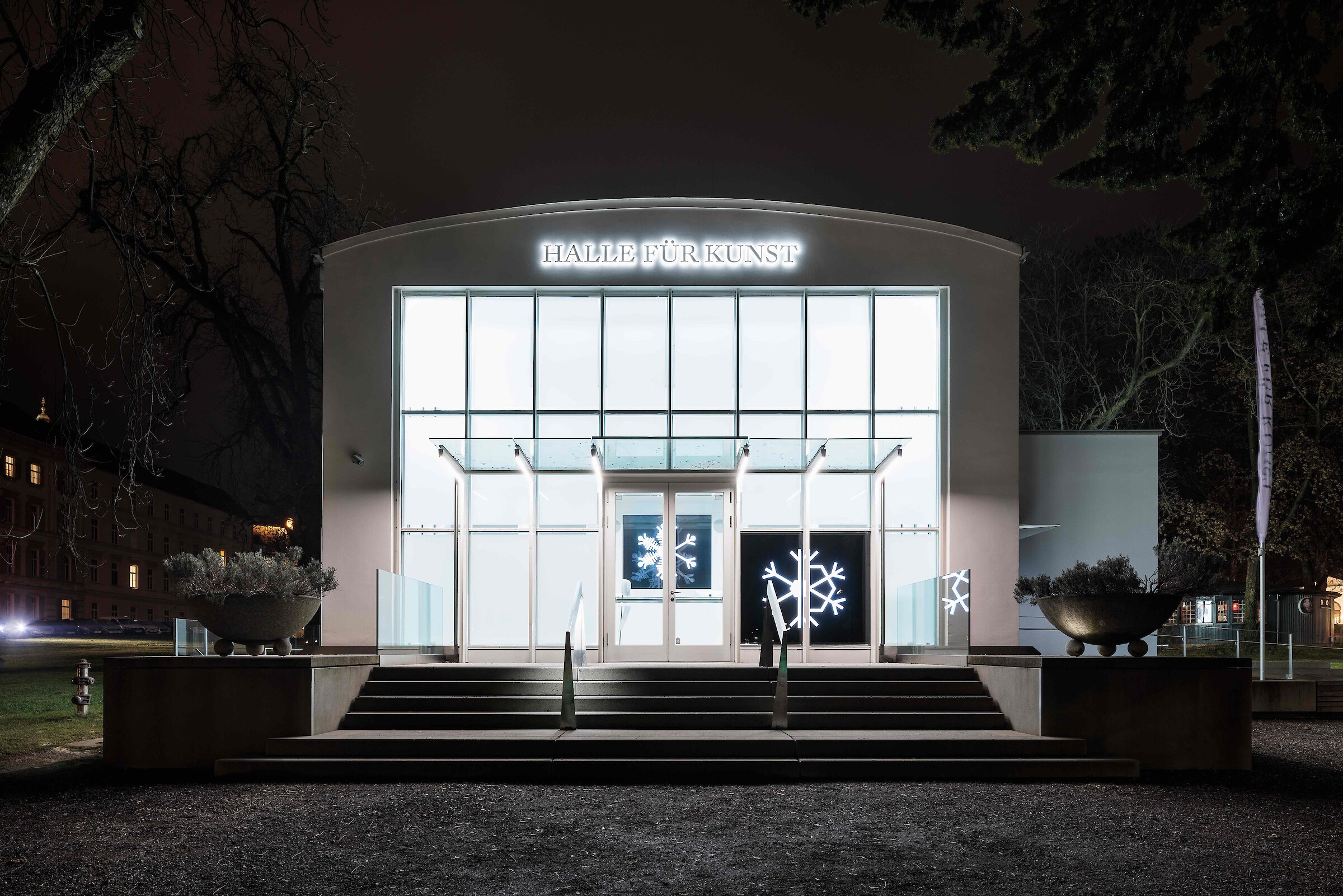Institution
2025 Program
HALLE FÜR KUNST is an innovative exhibition venue for contemporary and modern art production in an international context. At the same time, our program also recognizes regional art production. With these different perspectives HALLE FÜR KUNST Steiermark sees itself as a communicative institution that addresses the international within the context of the local. Using the various formats of solo exhibitions and thematic group shows, performances, and residencies, our curatorial team wishes to react directly to the manifold forms of expression in contemporary art production, and to offer a space open for the resonance of relevant discussions. The late-modernist architecture of the building (1952) and the surrounding park offer a special setting, and this physical space is complemented by the website in the form of a platform that reflects and disseminates our many different focuses and artistic productions.
As in previous years, our 2025 program is not based on any specific theme or leitmotif, but instead attempts to present the field of contemporary art in the most precise and diverse possible ways. The unifying element thus lies in the urgency of each format and its very own focus.
Surrealism and its after-effects are presented in an unusual reading in the three-part exhibition project Future of Melancholia, held jointly by the Museum of Contemporary Art in Belgrade (MoCAB) and HALLE FÜR KUNST Steiermark in Graz. Freely based on Robert Musil’s almost timeless novel The Man without Qualities, the gaze here is not just directed at a complex (shared?) past that is in many ways comparable to our present day, but also the often negatively connoted idea of melancholy as a potential driver of change. In Belgrade, ten carefully selected Austrian artists (amongst others Kamilla Bischof, Flora Hauser, Ernst Yohji Jaeger, Matthias Noggler, Anna Schachinger) are shown together with works by surrealism pioneer Susanne Wenger, and Philipp Timischl addresses the theme of melancholy in a new work. Almost simultaneously, there will be a comprehensive presentation from the collections of MoCAB and numerous other lenders in Graz, which, based on the surrealist Belgrade Group of the 1930s around its central character Marko Ristić, will explore the neo-surrealism of the postwar period and a new interest in present-day surrealist trends. The neo-Surealist artists include such diverse and exciting positions as Ilija Bašičević, Ljiljana Blaževska, Olga Jevrić, Bogoljub Jovanović, Radomir Reljić, Leonid Šejka and Sava Sekulić, most of whose works are being shown in Graz for the first time. A selection of current Serbian artists such as Lidija Delić, Milena Dragicevic, Biljana Đurđević, Vukadin Filipović, Marko Obradović, Marija Šević, Saša Tkačenko and Nina Zeljković round off the extensive project with a melancholy view of a present that seems to be continuing in repetitive loops into its more foreseeable future.
In summer 2025 HALLE FÜR KUNST Steiermark presents the first solo exhibitions in Austria by two internationally renowned emerging artists – British artist Louise Giovanelli and the Styrian artist Evelyn Plaschg, both of whom take a new approach to painting. The Giovanelli exhibition is held in cooperation with The Hepworth Wakefield (UK), showing the artist’s striking hypnotic paintings that emit light both visually and metaphorically. The exhibition title, A Song of Ascents, is taken from a series of religious psalms and indicates the phenomenon of ecstasy that is very much evident in hedonistic youth culture and in the fan-driven world of pop and art history. By contrast, Evelyn Plaschg’s paintings focus on the body, with particular reference to the artist’s own personal experience which she combines with fragments and excerpts from other contexts. Using simple gestures and large bodies, Plaschg creates intimate spaces and pulsating compositions that make viewing her work very much a physical experience.
In fall 2025, we present a key figure from the Argentinian art scene, Diego Bianchi, who will react to events on the streets of Buenos Aires, Paris, and Graz with his very diverse sculptural installations based on the human body. For this new work, Bianchi will manipulate discarded and found objects, such as automobile parts, plastics, and trash, and designed objects and items of fashion, attempting to bring together apparently contrasting worlds in his sculptures. These frequently include parts of shop-window mannequins and consumer goods that in their new context show the absurdity of our fascination for the world of commodities.
Over the coming year, performative works in various formats will again be included in our exhibition program. Already at the end of February, there will be a live reading of One Million Years by On Kawara over two evenings, with volunteers reading from this monumental book project by the influential Japanese artist. In this format, this work designed for infinity by one of the most important conceptual artists will be presented and brought to life in a very special way.
In September, Annemarie Arzberger will present a play for puppets using her own stage design, and thus for the first time develop her own work of theater for her fantastic figures made meticulously by hand, which so far have either been made for theater projects by other authors or seen as part of Arzberger’s exhibitions. Arzberger plays with the unfathomable and with her own dream-like narratives, and she has her puppets dance to these.
Our 2025 program will be accompanied by weekly events and educational formats, as well as informative online offers and publications, making HALLE FÜR KUNST Steiermark a venue where contemporary art can be experienced as an expression of our times.

HALLE FÜR KUNST Steiermark
Photo: kunst-dokumentation.com

Stano Filko, 12 Colors of Reality (Balloons), 1978 – 2011
Installation view, HALLE FÜR KUNST Steiermark, 2022
Courtesy The Slovak National Gallery, Bratislava

Tempel der Europa, Graz 2021
Installation view HALLE FÜR KUNST Steiermark in the frame of the exhibition _Europe: Ancient Future
Photo: kunst-dokumentation.com

Noah Barker,_SFS_GA22, 2023
5 chanel video
0:23 min.
Installation view, HALLE FÜR KUNST Steiermark, Graz
Courtesy der Künstler; Fanta-MLN, Milan
Photo: kunst-dokumentation.com
History and Mission
In conjunction with the Neue Galerie at the Landesmuseum Joanneum, the house was for decades the site of the legendary Three-Country Biennial Trigon, which was an essential platform for cultural exchange during the Cold War and thus established early links with numerous artists from the South-East European region, such as Marina Abramović/Ulaj, Sanja Ivecović, Mangelos, Gianni Colombo, Luciano Fabro, Luigi Ontani.
In the 1980s, when there was a direct connection between the Graz and Cologne art scenes through Martin Kippenberger and Jörg Schlick, among others, the Pavillion also hosted, for example, a groundbreaking solo exhibition by Albert Oehlen and then later, in the early 2000s, the first Austrian institutional solo exhibition by Cosima von Bonin.
In 2013, the Kunstverein Medienturm, under the artistic direction of Sandro Droschl, finally took over the building, which had previously undergone a general renovation, in order to establish it as an independent institution under the name Künstlerhaus, Halle für Kunst & Medien. The sophisticated and comprehensive program realized in this period can be viewed here: www.km‑k.at.
Under the same leadership but an institutional transformation and reorganization, in 2021 the team was pleased to present the HALLE FÜR KUNST Steiermark.
Today the exhibition house is dedicated to the presentation of contemporary, socially relevant art production in an international context, whereby the carefully presented art here should also consciously stand and speak for itself. At the same time, attention to local art production has a significant influence on the artistic program. Through these different perspectives, the Kunsthalle (hall of arts) positions itself as a progressive house that cannot think the international outside of the local context and vice versa. Through various formats such as solo and thematic group exhibitions, performances, and residencies, the curatorial team aims to respond directly to the diverse means of expression of today’s artistic production and to be an open place for the resonance of currently relevant discussions.
In doing so, the wonderful architecture and surrounding parkland provide a unique setting for such a program. Facing this physical space, the new website of the HALLE FÜR KUNST Steiermark is set up as a diversely playable platform that reflects the different focal points and artistic productions and carries them to the outside. Following this step of opening up, it is a great concern of the institution to make contemporary art accessible to all members of society, so that admission to the exhibitions is free and a versatile mediation offer is available.
By 2024, the HALLE FÜR KUNST will be a climate-friendly cultural centre. In order to sustainably reduce CO2 emissions and increase energy efficiency, the exhibition lighting was converted from neon light to LED lighting with funds from the European Union’s NextGenerationEU reconstruction and resilience fund, and a natural outdoor shading was installed in the foyer.
Come! into the open, friend!
–Friedrich Hölderlin, Der Gang aufs Land. An Landauer, 1800/01.
Sandro Droschl
Director, Chief-Curator
Helga Droschl
Managing Director, Press
hd@halle-fuer-kunst.at
Jan Tappe
Curator
jt@halle-fuer-kunst.at
Caro Rebecca Feistritzer
Curatorial Assistance, education
cf@halle-fuer-kunst.at
Wolfgang Oeggl
Technical Management
wo@halle-fuer-kunst.at
Katrin Schwarz
Office
ks@halle-fuer-kunst.at
Victoria Pollauf
Visitor Information
vp@halle-fuer-kunst.at
Leonie Kodritsch
Internship
Darek Murawka
Building Services, Setup
Mykhailo Skreklia
Setup
Ignaz Pickl
Promotion Poster
Anoka Visnjic-Jovic
Building Cleaning
General Information, Desk
info@halle-fuer-kunst.at
Aktuelle Jobausschreibungen
Kuratorische Assistenz, Produktion
- Ausschreibung PDF (64 KB)






